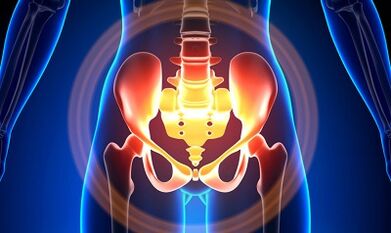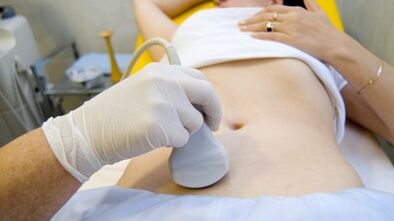
This disease has been poorly studied, although several thousand observations with diagnosis and subsequent treatment have been prescribed.
A lot of diversity and not -specification of the clinical appearance of varicose veins of the pelvis leads to major errors from the diagnosis, which in the future affects the consequences.
Characterization of varicose veins of a small pelvis
The pelvic veins are several times longer than the arteries, which determines their large capacity.This is due to the phylogenesis of the vascular system of the pelvic region.The pelvic veins have high adaptation capabilities and are potentially predisposed to restructuring, which contributes to the formation of a densely intertwined network.
The speed and direction of the blood flow is regulated by the valves, which are controlled by complex humoral mechanisms.The valves balance the pressure in different parts of the venous network.
When the valves cease to perform their functions, blood stagnation develops, this leads to the pathology of blood vessels and the formation of varicose veins.The peculiarity of the small pelvis veins lies in the fact that the wide uterine ligaments, which support the lumen of the broad boat, can also narrow it, causing a pathology.
Causes
Patological dilation of pelvic veins may be due to the following reasons:
- Violation of blood flow trails;
- Venous barrel prison;
- Compression of collateral trunks from the changed uterine position, for example, to retroflexia;
- Valve ovary failure (congenital or acquired);
- Post -inflamnation syndrome syndrome;
- Pathology of connective tissue;
- Arteriovenous angiiodisplasia;
- Prolonged landing, hard physical work;
- Varicose veins of the lower extremities;
- Pregnancy (3 or more) and childbirth (2 or more);
- Diseases of the female genital area (chronic salpingoophorite, ovarian tumors, uterine fibroids and genital endometriosis);
- Adhesive process of pelvic organs;
- Overweight
Classification by degree of disease
In terms of expanded vein, the following degrees are distinguished:
- Up to 0.5 cm, vascular stroke "Corkscrew";
- 0.6-1 cm;
- More than 1 cm.
Options for the course of the disease
- varicose veins of the perineum and vaginal vestibule;
- Complete venous syndrome -pelvic pelvis;
Symptoms
- The most common pain - the most common in the lower abdomen, the perineum after the long static and dynamic overload.Pain intensifies in the second stage of the cycle, after hypothermia, fatigue, stress, deterioration of various diseases.
- The feeling is "not quiet", pain with and after her.
- Dismenorrhea - menstrual disorders, including pain syndrome.
- Secret, more than normal, genital tract gallbladder.
- Blood stagnation leads to infertility, disability, termination of pregnancy.
- Urinary violations as a result of the expansion of the bladder veins.
Troubleshooting
Diagnosis of the disease only by complaints is successful in just 10 % of cases.
Palpation of the inner pelvis walls makes it possible to feel the prolonged seals and vein joints.When examined in the mirrors, the vaginal mucosa cyanosis is visible.

The procedure for choosing is an ultrasound study with the Doppler color map, which allows you to identify not only varicose extensions of ovarian veins but also venous thrombosis, posttrombophlebitic occlusion.With ultrasound, it is visible, "worms", structure without signal reflection, localized on the lateral surface of the uterus.
The effect of the doppler study is based on "coloring" in blue and red, venous and arterial blood, corresponding.
The ultrasonic examination apparatus using a special program recognizes the movement of blood from the sensor and in the other direction, calculates the velocity of the blood flow and the type of vessel.
But the exact definition of the vein is either the artery remains behind the doctor.The Doppler method works in almost all cases, our body dictates exceptions to the rules, as the blood flowing from the heart is not always arterial and vice versa.
Thus, a ultrasonic diagnostic doctor sees an arterial or venous vessel, its size, the degree of blood flow to it and many indications that an ordinary person does not need, but plays an important role in making a diagnosis.To do this, use transabdominal and transvaginal sensors.
In 5.7% of cases, the disease is recognized by the accident during examination.Normally, the ovaric egg diameter is 0.4 cm.
CT and MRI have great accuracy.Using these methods, you can find varicose veins accumulations in the uterine ligaments, ovaries and around these organs.It is possible to determine simultaneous pathology.
A very reliable method is a phlebographical study.
Contrast is performed at the roof of the Valsalva sample, against the bloodstream.It allows you to see the failure of the valves.
Retronenoscopy is also used on the left, renal phypho, super -pasteten phlebovarioscopy and phlebovariography on both sides are used.These methods allow you to determine the hemodnam and anatomical changes in the renal veins and the falling places in them gonadny veins.
Flebovarioscopy Super -Spant is performed by gonadic veins catheterization through an anti -Anasponal femur or subclavian vein, with subsequent introduction of contrast.
Most of the blood from the varicose vein with varicose horns is thrown through the ovarian vein.But in conditions of hypertension, it occurs through the uterine veins not corned in the inner iliac vein.The vein plexus, through which the leakage can occur, include sacral and bladder plexus.
In the Phlebo -Left wing imigography, 3 stages of venous stagnation are distinguished in the left plaster plexus of the left ovary:
- There is no leakage from the left ovary plexus or it is performed along an additional short path.
- There is an extra long way.
- Two extra output paths or an additional and auxiliary are visible.
In stages 2 and 3, the varicose veins of the right ovary cluster are formed.
Laparoscopy is used for differential diagnosis.The intricate pathological veins are in the ovaries, in the direction of round and wide ligaments.They look like large cyanotic conglomerates with a thin, tense wall.
The complexity of the diagnosis lies in the fact that the disease is often hidden behind the signs of the inflammatory process, is distinguished by the clinical manifestations, disguised under endometriosis, prolapse of the internal organs, post -surgery neuropathies and many extragenal diseases.
Treatment
The main purpose of treatment is to remove the reflux in the veins.In the initial stages of the disease, conservative treatment is used.In the late stages of the disease, the treatment of choice is surgery.
Conservative treatment

It consists of normalizing vein tone, improving hemodynamics and trophic processes.
Symptomatic treatment to eliminate individual symptoms.Josteroidal anti -inflammatory for pain, with bleeding - hemostatic therapy.
The main drugs in conservative treatment are venotonic medicines and antiplatelets.
Flebotonics - improve vascular wall tone and improve blood flow.With this disease, it is best to consult a gynecologist for certain medicines.
An important method is physiotherapy exercises.
Surgical treatment
- Varicose veins of the resurrection.
- Gonado-kavalri shunting.
- Sclerosis for laparoscopy.
- Occrame of the ovarian veins using X-ray-endovascular radius methods.
Folk remedies
Since the main thing in the occurrence of the disease is the weakness of the valve apparatus, all popular remedies used to expand the varicose veins of the lower extremities are also used for this pathology.
Most used: ordinary hazelnuts, hops, nettles, horse chestnut, dandelion root, tea mushrooms, willow, oak, St. John's Wort, a series, flower pollen and many other plants.
Effective is: Treatment with oak baths, chestnuts, willows, chamomile, pharmacy, drying herb, St. John's wort.
PREVENTION
- The first thing to do if there are complaints, predictors or diseases listed above - contact a gynecologist.
- It is necessary to normalize the work regime and rest, try not to stay in a straight position for a long time, physical strain.
- Perform "Pedal", "Stack Stand-up" exercises, "legs of the foot"
- Improve in the diet: Eat foods with high vitamins E, R, C, try to eat only white meat, less fat, replace it with fruits, vegetables, cereals.
- Drink a sufficient amount of liquid, but not less than 1.5 liters per day.
- Get rid of excess weight, bad habits.
- Consult your doctor who participates in the linen of compression linen, will improve blood flow from the lower extremities, thus there will be less stagnation in the pelvis.
- Avoid baths, saunas, steam rooms, hot baths.
In order not to get sick with such a difficult disease, it is necessary to follow the preventive recommendations listed above.Treat your health as the most valuable in life.
In the smallest suspicious symptoms that you cannot escape for a few days, you should consult a doctor.He should offer you highly qualified help and save you from suffering.























